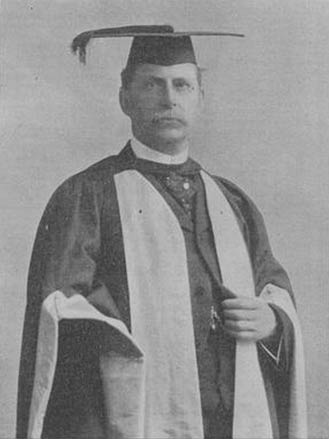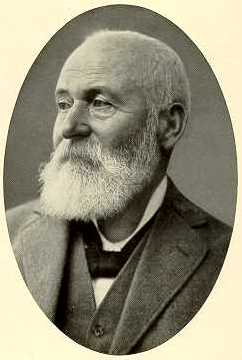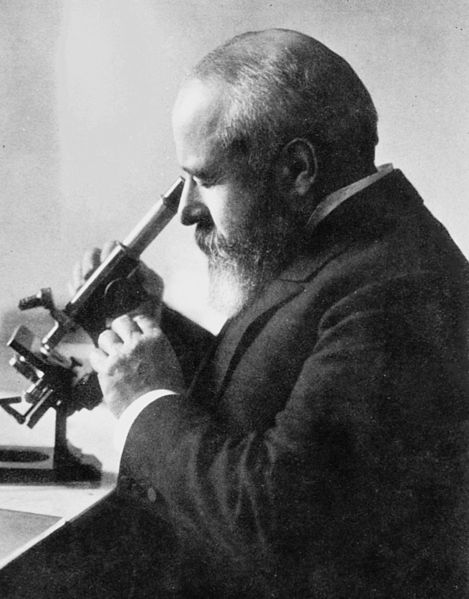<Back to Index>
- Dermatologist Henry Radcliffe Crocker, 1846
- Dermatologist Paul Gerson Unna, 1850
PAGE SPONSOR

Henry Radcliffe Crocker, MD, FRCP (6 March 1846 – 22 August 1909) was an English dermatologist. Originally from Hove in Sussex, Crocker started his working life as an apprentice to a general practitioner, before going to London to attend the University College Hospital medical school. Working as a resident medical officer with William Tilbury Fox, Crocker began a lifelong career in dermatology. With his 1888 book Diseases of the Skin: their Description, Pathology, Diagnosis and Treatment, he became known as a leading figure of dermatology.
Crocker was born in 1846 in Hove, Sussex, to Henry and Maria (née Walters) Crocker. His father was a chemist, a career that Crocker at first sought to take up. At 16, he left his private school in Brighton to take up an apprenticeship with a general practitioner. In 1870 he became a student at University College Hospital medical school in London. He worked part time as a drug dispenser in Sloane Street. As an undergraduate student, Crocker won gold medals in materia medica, clinical medicine and forensic medicine, as well as a university scholarship. Crocker was generally known by his middle name, Radcliffe, and throughout his career this was sometimes mistaken as the first part of his surname.
After receiving his Membership of the Royal College of Surgeons (MRCS) qualification, Bachelor of Science degree and then in 1875 his MD, Crocker obtained a position as resident obstetric physician and physician's assistant at University College Hospital. He then held posts at the Brompton Hospital for Consumption and Diseases of the Chest and Charing Cross Hospital before returning to University College Hospital as resident medical officer. He worked under dermatologist William Tilbury Fox, and began to develop his own dermatological career as assistant medical officer in the hospital's dermatology department. At this time, the practice of specializing in medicine was somewhat frowned upon in the United Kingdom (although more popular in continental Europe), but Tilbury Fox and Crocker were credited with bringing some structure to the field of dermatology.
From 1877, Crocker was a member (and later a fellow) of the Royal College of Physicians. Following the death of Tilbury Fox in 1879, Crocker succeeded him as physician in the department of dermatology at University College Hospital. In this position, Crocker was able to devote himself to the study of the skin and its diseases. Although a specialist, in his clinical work, he emphasized the value of treating the whole patient. His research concentrated on the epidemiology of skin diseases and histology, noting the importance of microscopic inspection of skin cells. During his career, he was the first to describe or name diseases such as granuloma annulare and erythema elevatum diutinum.
In 1888, Crocker published Diseases of the Skin: their Description, Pathology, Diagnosis and Treatment, a textbook that helped to establish him as a leading figure in dermatology.
At a meeting of the Pathological Society of London
in 1885, Crocker was the first to put forward a theory on
the condition of Joseph Merrick, known as the Elephant
Man.
Merrick was not present at the meeting, but surgeon
Frederick Treves, who had examined him, showed
photographs. Crocker had also had the opportunity to view
Merrick the previous year when he was exhibited at a freak
shop on Whitechapel Road. Crocker suggested that Merrick's
condition was caused by a combination of dermatolysis and bone
deformities, as a result of changes in his nervous system.
Crocker included a description of the case of Joseph
Merrick in his book, Diseases of the Skin: their
Description, Pathology, Diagnosis and Treatment.
Crocker married Constance Mary Fussell on 3 April 1880. She was the daughter of Edward Francis Fussell, a medical officer and doctor at Sussex County Hospital. They had no children.
He died on 22 August 1909, aged 63, whilst on holiday in
Engelberg, a village in Switzerland.
The cause of death was heart failure.


Paul Gerson Unna, (September 8, 1850, Hamburg – January 29, 1929, Hamburg) was a German physician specialized in dermatology and one of the pioneers in dermatopathology.
Paul Unna was the son of Moritz Adolph Unna, a physician from Hamburg. Unna was educated at the Gelehrtenschule des Johanneums. He began to study medicine at the University of Heidelberg, but had to interrupt it in order to fight in the Franco - Prussian war, where he was severely wounded. In 1871, he resumed his studies in Heidelberg and later went to the University of Leipzig, finally attaining a doctorate under Prof. Anatol Waldeyer in Strasbourg. His doctoral work was on the subject of the histology and development of the epidermis, and was published in 1876. The thesis contained a set of new ideas and aspects that were met with hard criticism. They were accepted only after some corrections were made.
He went on to receive his training in dermatology in Vienna, where he worked in cooperation with Ferdinand von Hebra, Moritz Kaposi and Heinrich Auspitz, among others.
After his return to Hamburg, Unna started working in the clinical practice of his father, then in the Sankt Georg Hospital. Unna's main interest resided on dermatology: he opened his own practice for skin diseases in Hamburg in 1881, and later opened the Dermatologikum private dermatological hospital in Hamburg Eimsbüttel, so that he could concentrate entirely on the field, beginning in 1884. In that year, Unna published his first book, Histopathologie der Hautkrankheiten (Histopathology of Skin Diseases), which exposed the entire knowledge in the field at that time and which made him one of the most prominent dermatologists of his time. Besides describing all known skin diseases, Unna proposed new therapies. Among the innovations, in 1886 he proposed the use of ichthyol and resorcinol against skin diseases.
He investigated the biochemical processes of the skin and was the first to describe the stratum granulosum. In 1894 he introduced layer projection as a method for skin investigations.
In 1907 he received the title of professor from the Hamburg senate, and in the following year he became the chief physician of the Eppendorf hospital. In 1919 he became a professor at the University of Hamburg, receiving the first chair for dermatology.
In 1927 he described for the first time what was to be called Unna's disease, a chronic disease of the skin with seborrhea of the scalp and of the areas in the face and trunk that are rich in sebaceous follicles. Also, a compression gauze used to treat venous leg problems is named Unna's boot.
For many years Unna cooperated closely with the pharmacist Paul Carl Beiersdorf. The street in Hamburg where the Beiersdorf company is located is named Unnastrasse in his honor.